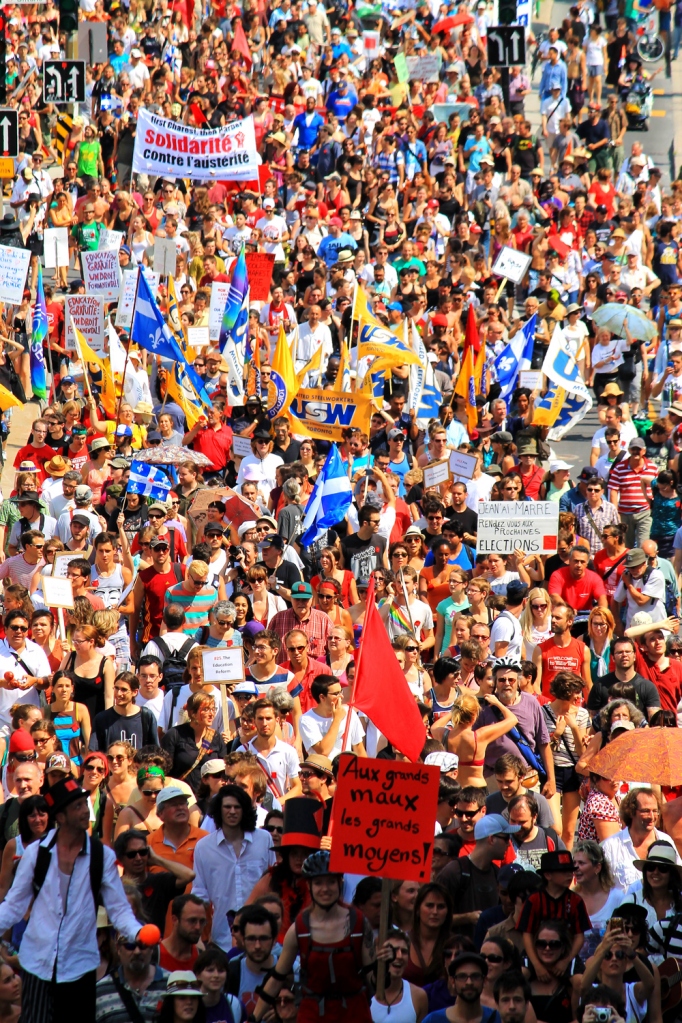The historic Quebec student strike has generated a number of lessons we can all take forward in the fight against austerity.
1. We can beat austerity
Premier Charest tried to raise tuition 75% to further the neoliberal assault on education and provoke students—hoping to use the resulting right-wing populist reaction to win another election. Students were subject to media attacks, ridicule from the Premier, police violence, and the draconian Bill 78—revealing the extent to which the 1% will go to impose austerity.
Yet the student movement remained united, mobilized wider support and built a historic movement that played a key role in running Charest out of office, out of his own seat, and securing the promise of the incoming PQ to abolish the tuition hike and revoke Bill 78 (law 12). In the process hundreds of thousands of students were educated in a semester of resistance that will shape struggles to come and have inspired people across Canada and around the world. Who’s laughing now, Mr. Charest?
2. Resistance is a process not an event
Though the Quebec Spring appeared to come out of nowhere for people outside Quebec, it has been a long time coming. Quebec’s history of resistance to national oppression has contributed to making it the site of the largest social movements of the last decade—from the anti-globalization protests of 2001, the anti-war protests of 2003 (which stopped Canada from officially participation), the mass May Day protest of 2004, and the mass student strike of 2005. The last strike, the latest in a history of student strikes in Quebec, trained a generation of student activists and defeated the government’s $103 million cuts to education.
This collective experience in Quebec became intertwined with the 2011 year of revolt triggered by the Arab spring to produce the “printemps érable.” The 2012 strike drew on local and global to build a mass strike from the ground up, department by department and campus by campus—an experience that can’t be spontaneously summoned but must be patiently built if we want to spread the Quebec spring.
3. Politics matter
It was not simply the scale of the attacks—from the 75% tuition hike to Bill 78’s attack on civil liberties—that spontaneously produced mass resistance, or the existence of general assemblies in the abstract. The politics that dominated the assemblies built the movement in a way that was both broad and radical.
First, the movement was built in an inclusive way so as to mobilize the greatest amount of opposition. While many at the heart of the movement believe in free education, the strike was initiated on the simple demand of “stop the hike”, to mobilize the greatest unity on this primary demand—and the resulting mass participation allowed for people to radicalize. When Charest imposed Bill 78, the movement responded by appealing to all those affected to rally in defense of civil liberties. By doing so the student strike turned the tables on Charest and broadened the resistance—encouraging casserole demonstration by many who had previously not taken part in the protests.
At the same time, a simple basis of unity against tuition hike and Bill 78 were framed in a context against austerity that built alliances with other groups—from the April 22 earth day demonstration that linked the student movement with the environmental movement against Plan Nord, to the solidarity with the locked out workers in Alma. As a result the student movement became a broader social movement.
4. Left parties can amplify movements
The history of social movements in Quebec has given rise to the left alternative Québec solidaire, a “party of the ballot box and the streets”, whose one MNA Amir Khadir was able to be a megaphone for the movement—encouraging resistance Bill 78, and getting arrested while joining the protests.
The election was dominated by two opposite but reinforcing currents that squeezed QS: a “radical” abstentionism that counterposes the streets and the ballot box and dismisses the importance of QS—surrendering the electoral terrain to the right—and an “anyone but Charest” argument that bolsters the PQ. But the disillusionment with the PQ and Liberals meant that they both lost support, with a right-wing populism turning with the CAQ.
Despite these dominant currents, QS won two seats (with well known feminist Françoise David joining Amir Khadir), came in second in two others, and increased their percentage of the vote. Combined with the higher voter turnout, this represents an important increase in support for QS—a doubling of the vote from 2008. QS helped build the Quebec spring and was in turn shaped by it, with many students joining its ranks, and is in a stronger position to continue giving voice to the movements in the future.
5. La lutte continue
This has just been the first chapter of the printemps érable. The support for the PQ is shallow, there is anger at the Liberals and false hope in the CAQ, like the ADQ before it, and all will show their united support for neoliberalism. The movement will need to keep asserting itself in the streets, campuses, neighbourhoods and workplaces, amplified by QS–to ensure the PQ maintains its promise of revoking the hike and the law, and to push the movement forward.
Unfortunately NDP leader Thomas Mulcair told his MPs not to support the student strike and then announced the NDP will run provincially—against QS. But the rapid spread of casserole demonstrations across the country shows the growing solidarity with Quebec and a desire to fight austerity locally. We need to learn the lessons of the Quebec spring by building broad movements from below, and having left parties that amplify and not dampen movements.



